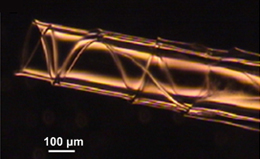歪み駆動自己ローリングによるハイブリッド有機-無機マイクロロールの作製:界面への自己集合粒子の導入
Strain-driven self-rolling of hybrid organic–inorganic microrolls: interfaces with self-assembled particles
2012年7月20日 NPG Asia Materials 4, e7 (2012) doi:10.1038/am.2012.40
ハイブリッド材料: 薄膜を巻く

このたび、大阪府立大学の高橋雅英教授をはじめとする日本とイタリアの共同研究チームによって、ワンステップで単層膜を巻いてマイクロチューブを作製する方法が考案された。これまでにも、金属から半導体、ポリマーに至るまでさまざまな材料の膜を巻いたチューブが作製されてきたが、それらは一般的に2層以上の不整合層からなる、層間の歪みを利用した方法を用いたものだった。そんな中、研究チームは今回、塩基性条件でグリシドキシ有機シラン誘導体を「ゾル-ゲル」法で合成し、得られた生成物をシリカ基板にスピンコーティングした後、乾燥させることによって、自己ローリング単層膜を作製した。形成された膜の底部は、上部よりも凝縮度が低いために水を優先的に取り込む。したがって、単に水に浸すだけで十分な歪みが生じ、基板から膜がはがれてマイクロチューブが形成されるのである。このマイクロチューブは、内部に分子や粒子などを捕捉することもでき、処理条件を調節することでチューブの直径も調節可能だ。この簡便な方法を利用すれば、膜を巻いて機能性材料を得ることも容易になるかもしれない。
Hybrid materials: Thin film on a roll
Researchers from Japan and Italy have devised a one-step strategy to roll single-layer films into microtubes. Films of materials ranging from metals to semiconductors to polymers have previously been rolled up. They typically consist of two or more mismatched layers, so that the scrolling process relies on the strain between layers. The researchers have now prepared a self-rolling single-layer film by ‘sol–gel’ synthesis of a glycidoxy-organosilane derivative in basic conditions, spin-coating of the product obtained on a silica substrate and subsequent drying. The bottom part of the film formed, less condensed than its upper counterpart, takes up water preferentially. Simply dipping it in water creates a strain that is sufficient to provoke scrolling. Species such as molecules or particles can be trapped within the resulting microtubes, whose diameters are controlled by adjusting the processing conditions. This simple and convenient method may facilitate preparation of rolls for functional materials.

